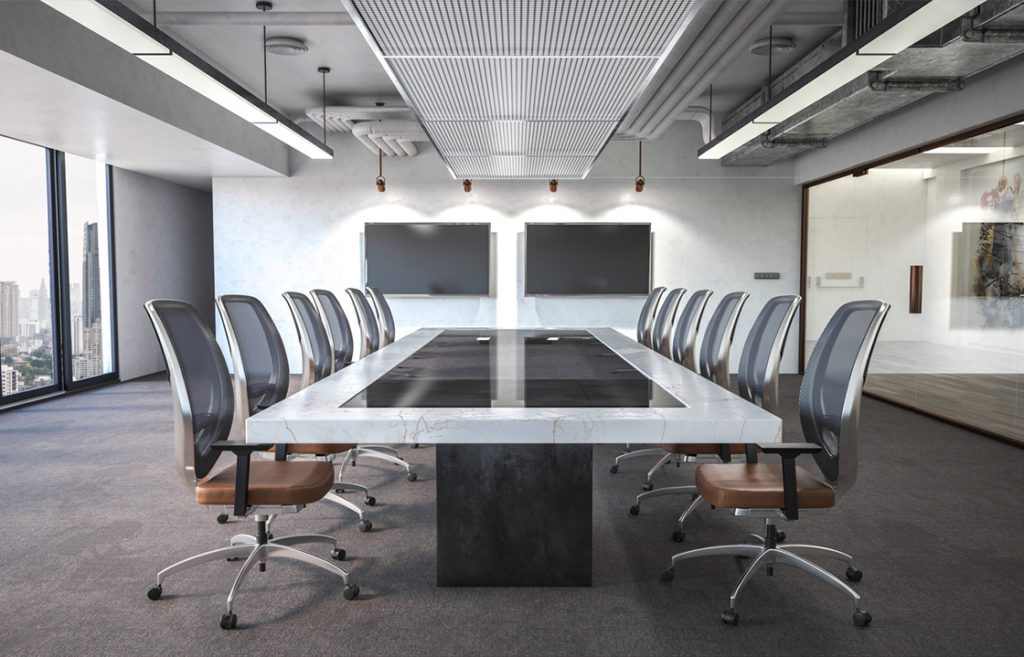The conference room has come through quite the revolution from the round table days that marked the last century –thanks to tech.
While it’s hard to tell what inventions tech may bring in the future, there’s just no going back to loudspeakers on the conference room table, struggling with PowerPoint presentations, or enduring shadows on projectors.
The modern conference room, as the present world demands, needs to be built for hybrid work and more activities than just meetings. As such, being intentional about making your conference room functional, comfortable, and aesthetically appealing can help you build a killer conference room.
This blog will teach you how to build a conference room that serves modern business needs.
1. Involve Technology Partners
90% of organizations have already hinted at getting a combination of remote and on-site work arrangements. For those who’ve already done so, there was a quick realization that the hybrid setting is convenient for meetings but not necessarily easy to hack. The right audio and video technologies are therefore a much-needed saving grace.
That’s why it’s vital to liaise with tech partners before you build a conference room and to involve them early. These partners have the best shot at uncovering opportunities to make communication work in instances where one piece of technology would not be enough.
2. Hire an Integrator
After your tech partners are in the know, the next step is hiring an integrator. The most important thing here is not really how good they are but what you want out of your conference room.
For instance, it makes little sense to pay for extra space with only half the employees on site. In this case, your primary goal is to maximize the small space and not necessarily bring in top-notch conference room technology.
Further, the tech not only needs to be functional but be maintained and show clear results –with the biggest one being greatly minimized or eliminated disruptions.
3. Scheduling System
Even with great working tech, a conference room may not support a hybrid working system with clashing schedules. Scheduling systems help to eliminate that clash.
Say an organization allows employees to choose any 3 days of the week to work from home and two days to work on-premise. These employees can book a shared space using a scheduling system on the days they plan to work on-premise to avoid inconveniences.
At the same time, managers can track how company resources are being utilized and integrators can program scheduling systems with permissions to prevent misuse or access to information to unqualified persons.
4. Lighting
Besides helping with camera angles and improving picture quality on video, lighting control technology is able to make people happier and more satisfied when attending meetings.
According to science, how a person judges the lighting in a room has a direct effect on their mood. For example, a person’s mood drops when they think the lighting in a room is too bright or too dim. Being able to control these aspects can be helpful to their well-being.
Installing smart lighting controls such as occupancy sensors with LED lights can identify the absence and presence of people and switch the lights off and on depending on the need. This also helps to save energy.
For aesthetic purposes, create balance with the rest of the space by matching the lighting with the conference style elements like the tables, ceiling design, walls, flooring, etc.
5. Audio
Because audio is the most important part of hybrid meetings, ensure your integrator works with your designer from the onset to prevent spending money on audio that just won’t work. Here’s a list of what you need to provide the best audio experience.
- Use Soft Surfaces
Popular hard surfaces – glass, bare wooden floors, drywall, and glass windows – won’t do well for your audio quality. Sound is a vibration, and hard surfaces reflect sound waves.
Reverberation occurs when a sound wave reflects. When reverberation builds up, it amplifies every tiny sound you can think of -including book page-turning- consequently drowning the presenter’s voice.
Go for fabric, carpet, and wood surfaces to help prevent echoes and reverberation. You could also choose chairs covered with cloth instead of hard predominantly metallic chairs.
- Sound Dampening Panels
Audiovisual integrators can also set up fixtures that enhance the sound system in your conference room. Acoustic panels, also known as sound-dampening panels, for example, use cloth or foam to reduce background sound.
A huge percentage of audiovisual installers advise a minimum of 15% coverage for the best possible audio quality. However, the number of panels you need depends on the size of your conference room.
- Install Your Audio Equipment Strategically
For your conference room to fully accommodate audio technology, use high-quality audio equipment such as microphones, speakers, and a control system.
Keep in mind that high-quality equipment does not insure you from audio issues. Strategic placement is a better guarantee because it captures sound better and prevents ambient noise. For example, if a microphone is closest to the speaker, it will be less sensitive to background noise.
Speaking of microphones, ensure that the room has enough high-quality microphones so that remote meeting attendees don’t struggle to hear –consider adding hand-held or lapel microphones to your stash of conference room audio equipment.
An audiovisual specialist can advise you on the best spots to place your audio equipment.
In Conclusion
Lastly, teach your employees how to use the equipment you integrate. It doesn’t help much if your IT department has to keep stepping in every time they need to use the conference room.
Plus, even if your conference room technology checks all the boxes for user-friendliness, it’s still essential to take your employees through guided training and ensure they understand how to troubleshoot.
Moreover, make a checklist of action points everyone needs before holding a meeting. It should include each step, from scheduling the meetings to inspecting equipment before a session starts.
Even better get the best audiovisual expert to help you integrate customizable technology so you never have to worry about underperforming tech.
For 33 years, VSGi has been providing top-notch AV technology solutions designed to give users unmatched audiovisual experiences. You can trust us to do the same for you too. Contact us today.

